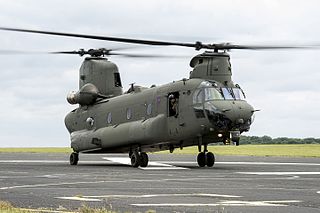| No. 586 Squadron RAF | |
|---|---|
| Active | 10 December 1943 – 30 December 1943 |
| Country | |
| Branch | |
| Role | electronic warfare |
No. 586 Squadron RAF was a proposed electronic warfare squadron of the Royal Air Force during the Second World War.
| No. 586 Squadron RAF | |
|---|---|
| Active | 10 December 1943 – 30 December 1943 |
| Country | |
| Branch | |
| Role | electronic warfare |
No. 586 Squadron RAF was a proposed electronic warfare squadron of the Royal Air Force during the Second World War.
The squadron was formed on paper on 10 December 1943. It was going to be an electronic warfare unit flying the Boeing Fortress Mk.II. It was decided to use 214 Squadron in this role and the squadron creation was cancelled on 30 December 1943, without it ever having any aircraft or personnel. [1]

Royal Air Force Waddington otherwise known as RAF Waddington is a Royal Air Force station located beside the village of Waddington, 4.2 miles (6.8 km) south of Lincoln, Lincolnshire in England.

Royal Air Force Odiham or more simply RAF Odiham is a Royal Air Force station situated a little to the south of the historic village of Odiham in Hampshire, England. It is the home of the Royal Air Force's heavy lift helicopter, the Chinook. Its current station commander is Group Captain Nicholas Knight OBE RAF.

Royal Air Force Wyton or more simply RAF Wyton is a Royal Air Force station near St. Ives, Cambridgeshire, England.

RAF Brawdy is a former Royal Air Force satellite station located 6.3 miles (10.1 km) east of St Davids, Pembrokeshire and 9.8 miles (15.8 km) south west of Fishguard, Pembrokeshire, Wales. It was operational between 1944 and 1992 being used by both the Royal Air Force and the Royal Navy before the site was turned over to the British Army and renamed Cawdor Barracks.

No. 34 Squadron RAF was a squadron of the Royal Air Force. During the First World War it operated as a reconnaissance and bomber squadron and in the 1930s operated light bombers. It was re-equipped with fighter-bombers in the later half of the Second World War and in the post-war period was reformed four times; first as a photo-reconnaissance unit, then anti-aircraft co-operation, then as a jet fighter squadron through the 1950s. It was last active in the 1960s, as a Blackburn Beverley transport squadron.

490 (NZ) Squadron was formed from pilots of the Royal New Zealand Air Force under RAF Coastal Command as an anti-submarine and reconnaissance unit.
No. 515 Squadron RAF was a squadron of the Royal Air Force formed during the Second World War. It ushered in Electronic countermeasures (ECM) warfare, jamming enemy radar installations from October 1942 as the only such squadron in the RAF initially. Later in the war 515 Sqn was joined by other squadrons as part of No. 100 Group RAF. The squadron disbanded after VE day, when the need for such a specialised squadron had reduced.

Royal Air Force Station Stornoway or more simply RAF Stornoway is a former Royal Air Force station near the burgh of Stornoway, on the Isle of Lewis, in the Western Isles of Scotland. No. 112 Signals Unit Stornoway was also part of the RAF's activity on the airfield.
No. 462 Squadron is a Royal Australian Air Force (RAAF) squadron which forms part of the Information Warfare Directorate in the RAAF's Air Warfare Centre. The squadron was first formed in 1942 as a heavy bomber unit and saw combat in this role in the Mediterranean area until it was disbanded in March 1944. It was reformed in the United Kingdom in August 1944 to participate in the bombing campaign against Germany, and in December that year converted to a specialist electronic warfare unit. No. 462 Squadron continued in this role until the end of the European war in May 1945 and was disbanded in September that year. The squadron was reformed in its current role during April 2005.

Royal Air Force Watton or more simply RAF Watton is a former Royal Air Force station located 9 mi (14 km) southwest of East Dereham, Norfolk, England.
No. 280 Squadron was a Royal Air Force air-sea rescue squadron during the second world war.

No. 192 Squadron was a Royal Air Force squadron operational during the First World War as a night training squadron and during the Second World War as a radar countermeasure unit. After the war the squadron served again in the Electronic Intelligence role, until disbanded in 1958.
No. 631 Squadron RAF was an anti-aircraft co-operation squadron of the Royal Air Force from 1943 to 1949.
No. 595 Squadron RAF was a squadron of the Royal Air Force from 1943 to 1949.
No. 587 Squadron RAF was an anti-aircraft co-operation squadron of the Royal Air Force from 1943 to 1946.
No. 246 Squadron RAF was a squadron of the Royal Air Force.

No. 355 Squadron RAF was a long-range bomber squadron based in British India from August 1943 until it disbanded in May 1946. Raised for service during the Second World War, the squadron was equipped with Consolidated Liberator aircraft and carried out operations against the Japanese during the Burma campaign.

Royal Air Force Angle, or RAF Angle, is a former Royal Air Force station located on the Angle Peninsula Coast, 8 miles (13 km) west of Pembroke, Pembrokeshire, Wales. It was operational from 1 December 1941 to the 1950s, having been used by both the Royal Air Force (RAF) and the Royal Navy.

No. 156 Squadron RAF was a Royal Air Force Squadron that was active as a bomber unit in World War II.

Cawdor Barracks is a British Army installation located 6.3 miles (10.1 km) east of St Davids, Pembrokeshire and 9.8 miles (15.8 km) south west of Fishguard, Pembrokeshire, Wales.